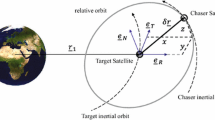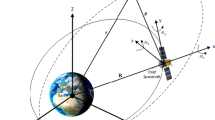Abstract
An impulsive control strategy for spacecraft formation flying is suggested considering secular drift between satellites. The drift motion caused by orbital period difference affects impulsive correction. Preventing the drift has been treated as a natural effort in most of formation flying researches. However, this study proposes preserving the drift behavior by delaying the period-matching maneuver. The paper shows that the impulse delay could be effective under some conditions by reducing the required delta-v. Two impulsive control methods are designed by harnessing the drift in pure Keplerian orbits. By using a linear approximation, the proposed methods avoid iterative steps for obtaining the required impulse, so the new strategy can be implemented with less computational burden compared to numerical optimal solutions. Impulse magnitudes between an existing method and the proposed strategy are compared mathematically and the numerical simulation verifies that the impulse reduction could be achieved with the suggested methods.












Similar content being viewed by others
References
Schaub, H., Junkins, J.L.: Analytical Mechanics of Space Systems. AIAA Education Series, AIAA (2003)
Alfriend, K.T., Vadali, S.R., Gurfil, P., How, J.P., Breger, L.S.: Spacecraft Formation Flying: Dynamics, Control and Navigation. Elsevier Astrodynamics Series, Elsevier (2010)
Schaub, H., Vadali, S.R., Junkins, J.L., Alfriend, K.T.: Spacecraft formation flying control using mean orbit elements. J. Astronaut. Sci. 48(1), 69–87 (2000)
Gurfil, P.: Control-theoretic analysis of low-thrust orbital transfer using orbital elements. J. Guid. Control. Dyn. 26(6), 979–983 (2003)
Vadali, S.R., Vaddi, S.S., Alfriend, K.T.: An Intelligent Control Concept for Formation Flying Satellites. Int. J. Robust Nonlinear Control 12(2), 97–115 (2002)
Irvin, D.J., Jacques, D.R.: Linear vs. nonlinear control techniques for the reconfiguration of satellit formations. In: AIAA Guidance, Navigation, and Control Conference (2001)
Park, H.E., Park, S.Y., Choi, K.H.: Satellite formation reconfiguration and station-keeping using state-dependent Riccati equation technique. Aerosp. Sci. Technol. 15(6), 440–452 (2011)
Lee, K.W., Singh, S.N.: Tuning functions-based output feedback adaptive spacecraft formation flying despite disturbances. Proc. Inst. Mech. Eng. K J. Aerosp. Eng. 226(1), 15–29 (2012)
Schaub, H., Alfriend, K.T.: Impulsive feedback control to establish specific mean orbit elements of spacecraft formations. J. Guid. Control. Dyn. 24(4), 739–745 (2001)
Anderson, P.V., Schaub, H.: Impulsive feedback control of nonsingular elements in the geostationary regime. In: AIAA Astrodynamics Specialist Conference (2012)
Sabol, C., Burns, R., McLaughlin, C.A.: Satellite Formation Flying Design and Evolution. J. Spacecr. Rocket. 38(2), 270–278 (2001)
Clohessy, W., Wiltshire, R.: Terminal guidance system for satellite rendezvous. J. Astronaut. Sci. 27(9), 653–678 (1960)
Gurfil, P.: Relative motion between elliptic orbits: Generalized boundedness conditions and optimal formationkeeping. J. Guid. Control. Dyn. 28(4), 761–767 (2005)
Xing, J., Tang, G., Xi, X., Li, H.: Satellite formation design and optimal stationkeeping considering nonlinearity and eccentricity. J. Guid. Control. Dyn. 30 (5), 1523–1527 (2007)
Vaddi, S.S., Alfriend, K.T., Vadali, S.R., Sengupta, P.: Formation establishment and reconfiguration using impulsive control. J. Guid. Control. Dyn. 28 (2), 262–268 (2005)
Breger, L.S., How, J.P.: Gauss’s variational equation-based dynamics and control for formation flying spacecraft. J. Guid. Control. Dyn. 30(2), 437–448 (2007)
Choi, Y., Mok, S.H., Bang, H.: Impulsive formation control using orbital energy and angular momentum vector. Acta Astronaut. 67(5–6), 613–622 (2010)
Mok, S.H., Choi, Y., Bang, H.: Impulsive control of satellite formation flying using orbital period difference. In: 18th IFAC Symposium on Automatic Control in Aerospace (2010)
Inalhan, G., Tillerson, M., How, J.P.: Relative dynamics and control of spacecraft formations in eccentric orbits. J. Guid. Control. Dyn. 25(1), 48–59 (2002)
Ichimura, Y., Ichikawa, A.: Optimal impulsive relative orbit transfer along a circular orbit. J. Guid. Control. Dyn. 31(4), 1014–1027 (2008)
Jifuku, R., Ichikawa, A., Bando, M.: Optimal pulse strategies for relative orbit transfer along a circular orbit. J. Guid. Control. Dyn. 34(5), 1329–1341 (2011)
Jones, J.B.: Optimal Rendezvous in the neighborhood of a circular orbit. J. Astronaut. Sci. 24(1), 55–90 (1976)
Leeghim, H.: Spacecraft intercept using minimum control energy and wait time. Celest. Mech. Dyn. Astron. 115(1), 1–19 (2013)
Acknowledgments
This research was supported by NSL (National Space Lab) program through the Korea Science and Engineering Foundation funded by the Ministry of Education, Science and Technology (S10801000123-08A0100-12310).
Author information
Authors and Affiliations
Corresponding author
Appendices
Appendix A: Tangential Impulse Difference in Case A
In Appendix A, the |Δv θ |diff between DIM and AIM in Case A are derived. For convenience, the tangential impulses of both methods in Eqs. 75 and 76 are rewritten as
The \(\left | {\Delta \mathit {v}_{\theta _{\text {in}} } } \right |_{\text {DIM}} \) and \(\left | {\Delta \mathit {v}_{\theta _{\text {in}} } } \right |_{\text {AIM}} \) depend on the four absolute terms consisting of the Δe. The Δe can be random in each mission, and for generality, the |Δv θ |DIM and |Δv θ |AIM for all possible Δe should be derived. The four Δe criteria, which make the absolute terms in Eqs. 75 and 76 be zero, are defined by
In Case A, the magnitude order of the Δe criteria can be determined by using the inequality a add>a 0>a d in Eq. 74:
Then, the Δe region can be divided into five intervals as
Now, the five |Δv θ |DIM and |Δv θ |AIM for each Δe interval are derived. Then, the smallest |Δv θ |diff is extracted. Because the |Δv θ |diff derivation procedures for the five intervals are the same, the |Δv θ |diff with the first Δe interval is only derived in detail. The derivations of the rest intervals are omitted and only the final results are shown. When the Δe is less than Δe 4, the |Δv θ | of DIM and AIM are obtained as
The difference of |Δv θ | between DIM and AIM become
The |Δv θ |diff for the other Δe intervals can be achieved by
Finally, the smallest |Δv θ |diff in Case A can be obtained from Eqs. 107–111 as
Appendix B: Tangential Impulse Difference in Case C
The |Δv θ |diff in Case C for the various Δe are presented. The four Δe criteria in |Δv θ | of DIM and AIM are defined in Eqs. 99–102. However, unlike Eq. 103 in Case A, the magnitude order of the criteria is not strictly fixed and it depends on \({\Delta } M_{\min }^{\prime } \). There are three possible cases:
where
The \({\Delta } M_{\mathrm {C}_{{1}} -\mathrm {C}_{{2}} }^{\prime } \) is the \({\Delta } M_{\min }^{\prime } \) boundary when Δe 4 = Δe 1, and the \({\Delta } M_{\mathrm {C}_{{2}} -\mathrm {C}_{{3}} }^{\prime } \) is the \({\Delta } M_{\min }^{\prime } \) boundary when Δe 3 = Δe 2. Now, the smallest |Δv θ |diff for the three cases in Eq. 113 are derived. Again, as Appendix A, the |Δv θ |diff derivation procedures of the three cases are the same. The first case, Case C1, is only analyzed in detail, and the final results are only given for the other cases. In Case C1, the Δe region can be divided into five intervals by
Applying each Δe condition into the |Δv θ | of DIM and AIM in Eqs. 99–102, the |Δv θ |diff for the five intervals can be derived by
where the Δa 0,add = Δa add−Δa 0. The minimum |Δv θ |diff in Case C1 is obtained at Δe = Δe 2 and the value is
The smallest |Δv θ |diff for Cases C2 and C3 could be obtained by the same approach of Case C1.
where the \(\left | {\Delta \mathit {v}_{\theta } } \right |_{\text {diff,C}_{2} } \) is equal to the \(\left | {\Delta \mathit {v}_{\theta } } \right |_{\text {diff,C}_{1} } \), and there exists the two minimum |Δv θ |diff candidates of Eqs. 122 and 124 in Case C.
Rights and permissions
About this article
Cite this article
Mok, SH., Choi, Y., Bang, H. et al. A Delayed Impulse Control Strategy for Spacecraft Formations. J of Astronaut Sci 60, 337–365 (2013). https://doi.org/10.1007/s40295-015-0055-z
Published:
Issue Date:
DOI: https://doi.org/10.1007/s40295-015-0055-z




